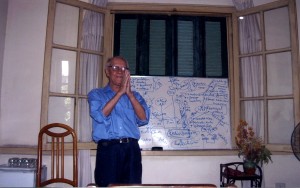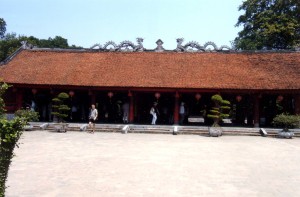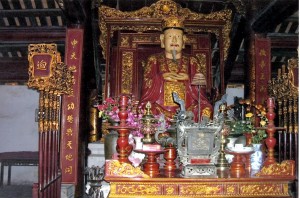A Tour Of Modern Vietnam
This is the fourteenth in a series of articles about traveling in Vietnam
A History Lesson In Hanoi
By Charles N. Stevens
Photos by Dolores Seidman
This morning our bus takes us to another part of Hanoi where we listen to a lecture about the history of Vietnam by Huu Ngoc, a renowned teacher and author. His English is good and his delivery is dynamic for an 88 year-old man. He had been an officer in the army and had met Ho Chi Minh three times during the war. He authored a thick book, Wandering Through Vietnam, for which he received a literary prize.
He tells us that Vietnam was occupied for a thousand years by the Chinese, but afterwards was independent for nine hundred years. The northern part of Vietnam had adopted the Chinese culture while the south resisted it. In 1858 the French began an eighty year domination of the country that ended in 1954 with a military victory by the Vietnamese at Dien Bien Phu. The country was then divided in to North and South Vietnam, the north leaning towards communism and the south capitalism. Ho Chi Minh, the George Washington of Vietnam hoped to unite his country. He wanted the United States to help him accomplish this, but since they were allied with the French, the Americans felt they should not. He then solicited the Chinese communists to help him unite the country, and the rest is history. This was a means to an end for Ho Chi Minh. Later he resisted communistic practices, especially land reform, eventually giving the land back to the people after government ownership of the land proved a disaster.
Now, years after the Vietnam War, the country is more pragmatic than strictly communistic.
After the lecture our bus takes us to West Lake where we stop at a brownstone memorial to Senator John McCain who parachuted into this lake when his plane was shot down. I am amazed that such a sculpture would be erected for an American, especially one who was their enemy. But since he is prominent in the United States, I suppose they are rather proud of the event. He had landed in the lake among beds of water hyacinth and morning glory. Bystanders thought he was dead, but when he began to swim they waded in and rescued him. Other sources claim that they also beat him.
Our next stop is at the Temple of Literature located in downtown Hanoi. What we see are the remains of a Confucian university and temple, some of it dating back to 1070 in the Li Dynasty. The day is clear, and a breeze that is almost cool soothes us as we walk the grounds. The university stems from the idea that a country should be great through education rather than war and conquest. Unfortunately the French destroyed much of the main university complex when they left. But as we stroll through the attractive courtyards, gates, ponds, lawns and ancient trees we can feel the peace the old students and scholars must have enjoyed. Tranquility of the mind was important for learning. It was this university that initiated the idea of testing and giving yearly examinations.
Two leaping stone carp are embossed over the arch of the first gate. They represent an old story about carp that were faced with jumping a waterfall. Many tried and failed, but the two that worked the hardest finally made it. The moral is that if one tries hard enough, he will succeed.
We walk through more gates, around pools and into courtyards. At the last courtyard are stone stellae resting on great stone turtles. The stellae bear the etched names of those students that earned their degrees hundreds of years ago. This university was in use until the seventeenth century when another campus was built in Hue. A small wren darts into the flower beds and scurries among the plants. I had hardly seen any birds in Vietnam, so this is a rarity.
Many people stroll in the courtyards, a popular place for both citizens and tourists. Butterflies flit among the flower blossoms and breezes rustle the trees, adding to the peacefulness of this sanctuary. Yet the subdued sounds of city traffic are all around us.
In the last temple is a large statue of Confucius wearing bright red robes. He has long fingernails and long ear lobes, a gold crown on his head. They worshipped him here as he represented love and helping one another. A woman bows her head and folds her hands before Confucius then places incense sticks in a pot of sand. The sweet fragrance of incense is heavy in the air.
Now out of the university and near a craft store we see a monk with shaved head, wearing saffron robes, begging for money as he holds out a metal bowl. Our guide tells us that he is not a real monk and that we shouldn’t give him any money.
Our last activity of the day is a visit to the water puppet theater. Scenery fills the back part of the stage while a large pool of water lies in front. A Chinese style orchestra and singers are in alcoves at the left of the stage. Although it took us a while to understand how it was done, the puppets are cleverly manipulated by people behind a curtain at the back of the pool using long hollow poles that can barely be seen under the water. Dragons swim, light up, breath smoke or sparks, fish jump in and out of the water and puppet-men cruise in little boats. The show is amazingly clever and entertaining. When the performance is over the puppeteers emerge from behind the curtain, stand in the water and take their bows to thunderous applause.
This is a perfect way to end our last full day in Hanoi and Vietnam. Tomorrow we shall leave by plane in route to Bangkok and our eventual trip home. But there will be one more morning to soak up the sights on our way to the airport.

Eighty-eight year old Huu Ngoc, renowned teacher, presents the entire history of Vietnam in one hour.

It is peaceful in the courtyards of the Temple of Literature even though the sound of the city is all around us.

Confucius wears his red robes in the Temple of Literature, the fragrance of incense all around us.



